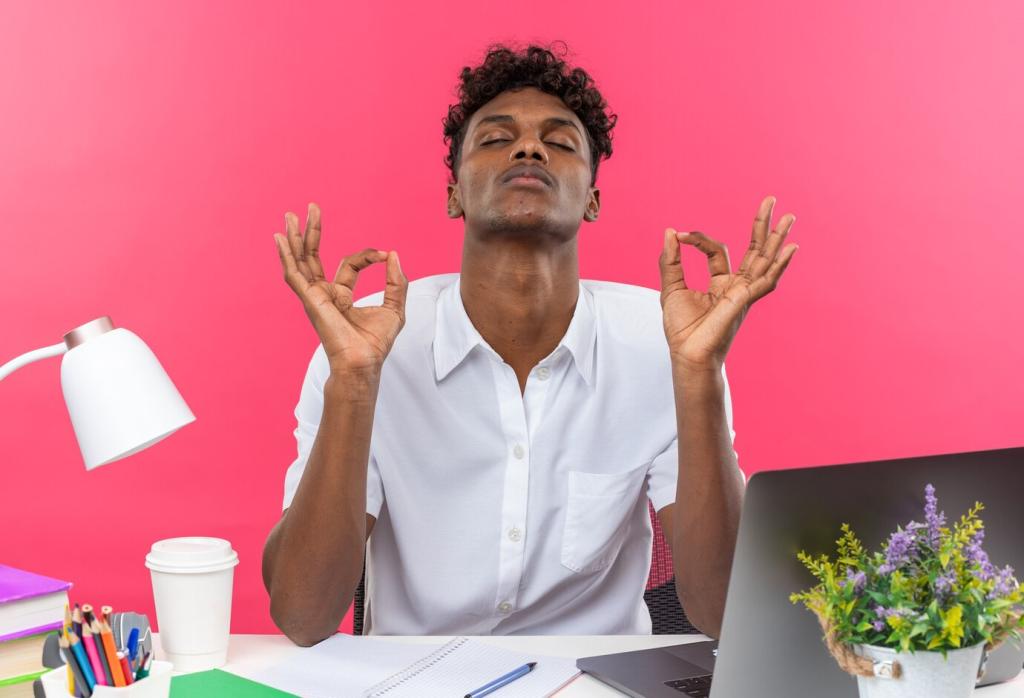
Relaxation Techniques to Enhance Mindfulness
Welcome to a gentler pace for your day. Chosen theme: Relaxation Techniques to Enhance Mindfulness. Together we’ll explore practical, science-informed rituals and heartfelt stories that help you breathe easier, notice more, and live with steady, compassionate attention. Join the conversation, subscribe for fresh practices, and share what helps you soften into presence.
Breath as an Anchor
Box Breathing Basics
Try four counts in, four counts hold, four counts out, four counts hold, tracing a soft square in your mind. Feel the cool inhale, warm exhale, and gentle pauses quiet wandering thoughts. Practice now, then comment with how your focus changed.


Physiology of Calm
Slow, nasal breathing nudges the vagus nerve and supports balanced heart-rate variability, a marker of resilience. Before you start, sense your pulse; after three minutes, check again. Notice subtler cues too: softened jaw, relaxed shoulders, and steadier attention.
Progressive Muscle Relaxation (PMR)
Start at the brow: gently tense for five seconds, then exhale and melt. Move through jaw, neck, shoulders, arms, torso, hips, legs, and feet. Pair each release with slow breathing. Ten minutes often reveals quieter thoughts and kinder inner commentary.
Progressive Muscle Relaxation (PMR)
Over-squeezing can backfire. Use about seventy percent effort, never pain. Keep breathing, unfurrow the brow, and whisper a cue word like “soften now.” Which muscle traps your stress most—jaw, shoulders, or calves? Share below so others can try targeted releases.

Sound and Silence
One-Song Listening Practice
Select one song. Sit comfortably, close your eyes, and follow individual instruments as they enter and fade. Breathe with the tempo, noticing micro-pauses. When distraction taps your shoulder, nod, smile, and return. Comment with the song that helped you settle today.
DIY Soundscape
Record your own textures: rain, kettle steam, the evening city hum. Layer softly or loop a single tone. Many find brown or pink noise masks chatter without fatigue. Keep volume gentle. Share your favorite ambient ingredients to help others craft soothing backgrounds.
Silence Minute Ritual
Set a one-minute timer. Airplane mode on. Sit tall, let shoulders drop, and listen into the quiet between sounds. Count two slow breaths. Notice the room’s hush deepen your awareness. Try this on the hour and report how your focus evolves.
Micro-Relaxations for Busy Days
Take three slow breaths, relax three muscle groups, and name three things you can see. This under-one-minute ritual interrupts tension loops and refreshes perspective. Use it before task switches. Share where it helps most—meetings, parenting, commuting, or creative blocks.

Sky-Gazing Breath
Look up if you can, indoors or out. Soften your gaze and extend exhales by a count or two. Notice the openness above welcoming your thoughts to spread out. Share how the sky’s color today influenced your mood and breathing rhythm.
Green Microbreaks
Place a plant near your workspace. For thirty seconds, trace a leaf’s veins, note subtle gradients, and breathe slowly. Many people report clearer focus afterward. Tell us which plant keeps you company and how it shapes your mid-afternoon energy.
Bring Nature Indoors
Add gentle natural textures—wood, stone, or linen—and let fresh air circulate when possible. Brew herbal tea and notice steam curls. These small touches make relaxation practices inviting, helping mindfulness become a lived-in habit rather than an occasional event.
Evening Wind-Down
Light and Screens
Dim lights, shift screens warmer, and choose calm inputs for the final hour. Pair with slow nasal breathing and gentle stretches. A steady bedtime anchors the rhythm. Subscribe for weekly wind-down prompts that keep your evenings kind and consistent.
Gratitude Debrief
Write three small gratitudes—mundane is perfect. Follow with a three-minute 4–6 breath, longer exhale than inhale. Notice shoulders drop and thoughts soften. Share one gratitude in the comments to nudge someone else’s evening toward ease.
Body Clock Consistency
Wake times shape nights. Aim for regular mornings, early light exposure, and a short, mindful stretch. Track five days and watch how calmer evenings ripple into clearer mornings. Report your results so we can refine these relaxation techniques together.
